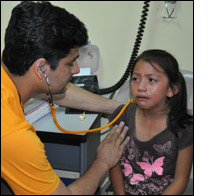Yadwinder Dhillon, MD: MMC Internal Medicine Resident
Guatemala: July 2011

I have served rural and underserved populations before so I thought this experience will not be much different and shall not be any more challenging. For
sure I was in for a surprise.
Nearly 11,000 people live in Guatemala City dump communities; more than half are children and are derogatively called scavengers by the locals as their
sustainment is by picking through garbage. Their average daily earning is $2.50 to 5.00. Hunger, illness, drug addictions, broken homes and gang wars are
rampant in community. It's a place of little hope.
A sphygmomanometer, a stethoscope, a torch, a thermometer and a glucometer is all the technology that was at my disposal. I tried to put them to best use,
you may doubt but there's a lot that you can offer by combined use of these instruments and your brain. It was very limited that I could do since I was
there for a short period but I saw and tried to manage as much as I could. Half of what I saw was Infectious (T.B, GI infections, Skin infections, wounds
etc.)Diseases other were chronic problems like high blood pressure, diabetes, stroke, angina, seizure disorder, malnutrition, joint diseases, some trauma
(lacerations). I worked at two clinics one setup at Potters House building at the edge of the dump another one in the administrative shed inside the dump.
Two half days I walked in the community to see people who couldn't visit the clinic. There's a lot more that I need to say to describe the whole experience
but due to word limit will close quoting these two statements-